Vol 3 No. 30 TROPIC LIGHTNING NEWS July 22, 1968
Index
Tropic Lightning Hails Division Association
At Cu Chi
Gen Abrams Confers DSC’s For Heroism
CU CHI - General Creighton W. Abrams, Commander of U.S. Forces in
Vietnam, arrived here July 9 to present the Distinguished Service Cross, our
nation’s second highest award for heroism, to four 25th Inf Div soldiers.
The four honored soldiers were Captain Malcolm C. Otis of B Trp, 3d
Sqdn, 4th Cav; Second Lieutenant Gordon F. Kelley of Co C, 2d Bn (Mech), 22d Inf;
Sergeant First Class Vincente T. Dydasco, Co C, 1st Bn, 27th Inf and Staff
Sergeant Daniel L. Ireland, Co C, 2d Bn, 14th Inf.
Arriving at Cu Chi at 9:15 a.m., General Abrams landed at the 2d
Bde helipad where he was met by Brigadier General William T. Gleason, acting
division commander.
Following the presentation, Gen. Abrams spoke directly to the
soldiers.
“We’re here this morning to pay tribute to the heroic
accomplishments of four men. That’s what makes the world worth living in
. . . men. Good men, courageous men and strong men . . . men who believe
in themselves; men who believe in their government.
“As long as we have enough men willing to sacrifice to be free,
we will continue to have that freedom.”
CPT Otis, of Vicksburg, Michigan, was cited for action on January
31 of this year. He played a decisive role in the defense of Tan Son Nhut
Air Force Base during the Tet Offensive. His troop was called upon to
repel an enemy penetration at the west end of the air strip.
2LT Kelley of Bar Harbor, Maine, received the DSC for valorous
actions on January 2 while defending Fire Support Base Burt, eight kilometers
from the Cambodian border.
SFC Dydasco of Guam personally destroyed seven enemy bunkers when
his unit came upon an enemy force of unknown size October 28, 1967 in the Boi
Loi Woods.
SSG Ireland, of Mooresville, Indiana, earned his DSC on Operation
Yellowstone January 17, when his unit came under intense attack. After
being knocked unconscious by an exploding claymore mine, he took over a machine
gun from the wounded gunner and blasted away at the enemy.
(More on Page 6)
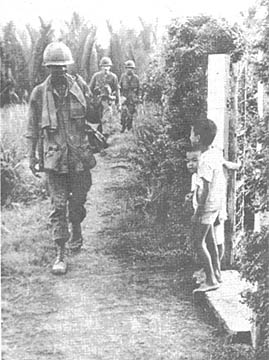 |
HELLO BABY-SAN - Specialist 4 Milton L. Welch of Detroit, waves hello to local Vietnamese children during a 2d Bn, 14th Inf, 25th Inf Div sweep three miles southwest of Saigon. |
Bucket No Good As Cong Cover
3D BDE - The elusive Viet Cong are well known for their ability to
hide almost anywhere. Sometimes, though, Charlie is found in places that
surprise even experienced field troops.
Such was the case with Second Lieutenant Stephen A. Degnan from
Reno, Nev, forward observer for Delta Co, 3d Bn, 22d Inf.
While the company was conducting a day patrol northwest of Saigon,
two VC were spotted running toward a nearby treeline. The “Regulars”
opened fire on the fleeing enemy and moved in to sweep the area.
Advancing through a vegetable patch, LT Degnan spotted a shallow
well and stopped to investigate.
“I thought the VC might have hastily stashed something down
there,” commented the FO, “so I hauled up the bucket. I found myself staring
at a Viet Cong.”
The enemy soldier had been holding the bucket over his head to
avoid being seen.
NVA Starts Action-Packed Nite
2D BDE - An NVA officer caught out after curfew and a face-to-face
duel with “Charlie” were just part of an action-packed night for the men of
the 1st Bn, 27th Inf’s Recon Plt.
The excitement began when the platoon’s lead element encountered
a man on the outskirts of Hoc Mon after curfew. The platoon leader, First
Lieutenant Robert J. Foran, Jr., of Waldwick, N.J., stopped him for questioning,
and the “Wolfhound” soldiers searched the bag he was carrying. Among
its contents were an NVA “Hard Corps” scarf and documents, identifying him
as an NVA officer.
When the scarf was removed the man tried to escape but infantrymen
opened fire as he broke away. A more thorough search of his body revealed
a loaded, ready-to-fire 9mm pistol strapped to the inside of his leg under his
clothing.
At the same time the lead element was interrogating the NVA
officer, the rear security element halted and began questioning three men out
after curfew.
As they were getting organized, the patrol received intense AK-47
rifle from their right flank. One of the three detainees was killed by
enemy rounds during the fight. The other two attempted to escape but were
killed as they dashed into a nearby hootch.
Soon after the right flank came under fire the left flank also drew
fire. Illumination rounds were called in, and the platoon opened up with
all organic weapons, including M-16’s, M-60’s, M79 grenade launchers and
claymore mines.
During the fight, Private First Class James T. Bailey, Royal Oak,
Mich., came face to face with “Charlie.” He recounted the incident:
“During the fight I couldn’t see what was going on so I got up and attempted
to move around the hootch that was blocking my view. Just as I did I came
face to face with a VC carrying an AK-47.
“Out of instinct I dropped backwards to the ground. I had
my weapon on automatic, and as I dropped I gave a steady pull on my trigger.
I think he did the same with his AK. I guess my M-16 was faster than his
weapon.”
“This morning after breakfast,” Bailey continued, “I noticed
an AK hole in my pants leg entering in the front and exiting at knee level.”
Sergeant Frank E. Langford, of Madison, Ala., also had a close call
during the exchange. He recalled that while the squad was receiving fire
from the right he “happened to check our rear and saw a VC crawling up on us.
I slowly turned and let him get within 10 meters of me and then opened up with my M-16.”
Sampans Seem Like Shooting Gallery - 3/22
2D BDE - Like ducks in a shooting gallery, the Viet Cong in sampans
floated past a 3d Bn, 22d Inf, ambush patrol set up on the banks of the Saigon
River.
“Soon after we had set up the ambush we spotted a series of
sampans floating down the river with the tide towards Saigon,” Sergeant Daniel
L. Geotz, said. “It was difficult to see, but it looked as if there were
as many as 12 sampans.”
The sighting was reported to the Bravo Co Commander, First
Lieutenant Dean Walker, to gain clearance to engage the sampans. Geotz explained
that clearance was needed because a nearby ARVN compound was resupplying by
sampan.
“It was agonizing to watch these sampans float toward us without
being able to do anything about it. But in a few seconds we received the
clearance to open fire,” Geotz said. “We could see VC jumping out of
the sampans after we opened fire.”
Before the fighting stopped, 12 Viet Cong had been killed and six
of their sampans destroyed.
BG Long New ADC-M;
Arrives From USAREUR
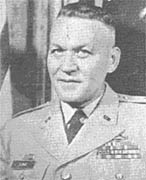 Brigadier General Glen C. Long arrived 11 July in the 25th Infantry
Division to assume duties as Assistant Division Commander for Maneuver.
Brigadier General Glen C. Long arrived 11 July in the 25th Infantry
Division to assume duties as Assistant Division Commander for Maneuver.
He replaces Brigadier General Donald D. Dunlop who is now serving
in Bien Hoa as Deputy Senior Advisor, III Corps.
General Long was born in Grimes, Oklahoma on 16 August, 1918.
He was graduated from high school in Stillwater, Oklahoma in 1935 and from
Oklahoma State University in Stillwater, in 1940, B.S. in Chemical Engineering.
He entered active duty with the 2d Inf Div as a Second Lieutenant,
Infantry in 1940 under the provisions of the Thompson Act and was commissioned
in the Regular Army in July, 1941.
During World War II, Gen. Long served successively as a Co CO,
Regimental S2, Bn Executive and Bn Commander, 363d Inf Regt, 91st Inf (Powder
River) Div. In Italy, he commanded the 3d Bn, 363d Inf Regt during the
Rome-Arno, Northern Appenines and Po Valley campaigns.
For its action during the Northern Appenines Campaign, the 3d Bn,
363d Inf Regt was awarded the Distinguished Unit Citation. Gen. Long was
awarded the Silver Star and Bronze Star medals and the Purple Heart.
(Continued On Back Page)
| AN EDITORIAL The 19th Annual Reunion of the 25th Infantry Division Association will be July 26-28 in Richmond, Va. We of the Tropic Lightning Division salute all Association members of this grand occasion! The aim of the Association is to keep Tropic Lightning soldiers together after their tours are over. This is accomplished through their reunion and various other fraternal functions. The Association has a long and honored history of service to 25th Infantry Division soldiers - past and present - and to their dependents. One such service program is the Educational Memorial Award which permits the presentation of scholarships of $1,000 to Tropic Lightning soldiers of active duty, sons or daughters of Division soldiers killed in active combat and sons or daughters of Association members. For information concerning the 25th Infantry Division Association, contact: Secretary-Treasurer 25th Infantry Division Association P. O. Box 101 Arlington, Virginia 22210 The 25th Infantry Division Association is unique to you, be a part of it! |
Page 2 TROPIC LIGHTNING NEWS July 22, 1968
Decorated
| DISTINGUISHED SERVICE CROSS | |
|
CPT Malcolm D. Otis, B Trp, 3d Sqdn, 4th Cav 2LT Gordon F. Kelley, Co C, 2d Bn (Mech), 22d Inf |
SFC Vicente T. Dydasco, Co C, 1st Bn, 27th Inf SSG Daniel L. Ireland, Co C, 2d Bn, 14th Inf |
|
SILVER STAR |
|
|
COL Raymond O. Miller, HQ, 2d Bde MAJ John P. Massey, HHC, 4th Bn, 9th Inf CPT Michael Wikan, Co C, 2d Bn, 27th Inf CPT Charlie W. Smith, HHB, 7th Btry, 11th Arty SGM Yukio Suenishi, HHC, 2d Bn, 12th Inf SFC Albert J. White, Co D, 4th Bn, 90 Inf PSG Arlo Huffaker, Co A, 3d Bn, 22d Inf SSG Frank J. Kistler, A Trp, 3d Sqdn, 4th Cav SSG Freedie C. Faulkner, Co A, 2d Bn, 22d Inf SSG Raymond J. Coss, Co C, 1st Bn, 5th Inf |
SGT Larry Hensley, Co C, 1st Bn, 5th Inf SP4 Alfred Delone, Co C, 1st En, 5th Inf SP4 James R. Askelson, HHC, 2d Bn, 34th Armor SP4 Eric C. Whitmen, HHB, 7th Bn, 11th Arty SP4 Larry Kimbrell, Co A, 3d Bn, 22d Inf SP4 Gary L. Davis, Co A, 2d Bn, 22d Inf SP4 Thomas L. Foster, Co A, 4th Bn, 23d Inf SP4 Terry L. Bronschidle, Co A, 2d Bn, 12th Inf PFC Russell R. Ruuska, Co B, 4th Bn, 9th Inf |
|
ARMY COMMENDATION MEDAL (HEROISM) |
|
|
CPT Robert Hemphill, Co B, 3d Bn, 22d Inf CPT Barry W. Lambert, Co A, 25th Avn Bn 1LT Antonio F. Sanpere, Co B, 2nd Bn, 14th Inf 1LT Edward C. Schott, Co D, 25th Med Bn 2LT Paul J. Wilson, Co B, 4th Bn, 9th Inf 2LT Yven C. Veenstra, Co B, 4th Bn, 9th Inf 2LT Donald G. Walker, Co B, 4th Bn, 9th Inf WO1 Joe F. Shipes, Co B, 25th Avn Bn MSG Frank L. Spilman, HHC, 25th Inf Div SGT Danny S. Thompson, Co C, 2d Bn, 14th Inf SP5 Robert C. Jones, HHC, 1st Bn, 5th Inf SP5 Jimmy D. Gross, B Trp, 3d Sqdn, 4th Cav SGT Michael O’Donnell, HHC, 3d Bn, 22d Inf SGT William A. Jadron, HHC, 3d Bn, 22d Inf SGT Steven W. Shearer, HHC, 3d Bn, 22d Inf SP5 Leroy A. Graunke, Co B, 1st Bn, 27th Inf SGT Eugene I. Weems, Co A, 4th Bn, 9th Inf SGT Richard Hildebrant, Co B, 3d Bn, 22d Inf SGT Barry E. Stover, Co B, 3d Bn, 22d Inf SGT Gerald L. Todd, Co B, 2d Bn, 22d Inf SGT Larry D. Fetters, B Btry, 7th Bn, 11th Arty SGT Billy J. Spraggins, Btry A, 1st Bn, 8th Arty SGT Michael J. Breen, Co A, 1st Bn, 27th Inf SGT Gregory A. Smith, C Btry, 7th Bn, 11th Arty SGT Jackson D. Bowman, Co D, 3d Bn, 22d Inf SP4 Chester H. Walker, Co A, 2d Bn, 12th Inf SP4 Denny R. Head, Co A, 2d Bn, 22d Inf SP4 Samuel Burrola, Co A, 2d Bn, 22d Inf SP4 Patrick Hoffman, Co B, 2d Bn, 22d Inf SP4 Alien Hoskin, Co B, 3d Bn, 22d Inf SP4 Gerald L. Dunbar, Co B, 3d Bn, 22d Inf SP4 Anthony C. Giovanni, Co B, 3d Bn, 22d Inf SP4 James Bowton, Co B, 3d Bn, 22d Inf |
SP4 Peter Mager, B Trp, 3d Sqdn, 4th Cav SP4 Keith D. Washington, B Trp, 3d Sqdn, 4th Cav SP4 Edwin J. Szelmeczka, HHC 2d Bn, 22d Inf SP4 Roger D. Baldwin, HHC, 2d Bn, 22d Inf SP4 Dennis L. Butler, Co C, 2d Bn, 22d Inf SP4 Dale W. Mancke, HHC, 3d Bn, 22d Inf SP4 Aubrey Corley, Co A, 2d Bn, 22d Inf SP4 Thurman Cooley, B Trp, 3d Sqdn, 4th Cav SP4 Luke S. Dease Jr., A Trp, 3d Sgdn, 4th Cav SP4 Richard M. Hawk, A trp, 3d Sgdn, 4th Cav SP4 Paul T. Grissom, C Btry, 7th Bn, 11th Arty SP4 Richard L. Peeler, C Btry, 7th Bn, 11 th Arty CPL Richard J. Walker, C Btry, 7th Bn, 11th Arty SP4 Rudy R. Cegallos, C Btry, 7th Bn, 11th Arty SP4 Edward J. Swift, B Trp, 3d Sqdn, 4th Cav SP4 Robert M. Berger, Co B, 4th Bn, 9th Inf SP4 Don L. French, Co A, 1st Bn, 27th Inf SP4 Charles Hamstra, Co A, 1st Bn, 27th Inf SP4 Tommie K. Speaks, Co A, 1st Bn, 27th Inf SP4 Roger Juhl, C Btry, 7th Bn, 11th Arty SP4 Arthur E. Clayborne, B Trp, 3d Sqdn, 4th Cav SP4 Arnold Domin, B Trp, 3d Sgdn., 4th Cav SP4 Alva W. Justice, Co B, 4th Bn, 9th Inf SP4 David D. King, C Btry, 7th Bn, 11th Arty PFC Kenneth R. Ausmus, B Trp, 3d Sgdn, 4th Cav PFC Jesus M. Zamora, C Btry, 7th Bn, 11th Arty PFC Richard Holt, C Btry, 7th Bn, 11th Arty PFC Ismael Oliveras, Co D, 3d Bn, 22d Inf PFC Walter J. Christy, A Trp, 3d Sqdn, 4th Cav PFC Revis L. Caskey, HHC, 1st Bn, 27th Inf PFC Henry R. Richardson, Co B, 4th Bn, 9th Inf PFC Stanley J. Bilwin, B Trp, 3d Sgdn, 4th Cav |
Earn Points For Diploma At Cu Chi School Center
CU CHI - Going to school in a combat zone? Many 25th Inf Div
soldiers are doing it through the facilities of the Education Center at Cu Chi.
Daily except Sunday from 6 p.m. until 9 p.m. soldier students attend high school
and college-level classes.
Some of the course offerings: English, Introduction to Business,
Accounting, College Algebra, International Relations, Western Civilization,
Sociology and Psychology. These courses and others may also be taken as
correspondence courses handled through the Center.
After completing any of the college-level courses a soldier may
take a standardized test. Upon passing it he receives a Certificate of
Completion which is accepted as credit by the majority of colleges in the U.S.
The Center also administers the General Education Development (GED)
test for those who have not completed high school and wish to obtain an
equivalence certificate.
To teach at the Center, instructors must have at least a
Bachelor’s degree.
The Education Center also counsels those who want to attend college
after the service. The Center has many college catalogues, directories and
fact books and will obtain upon request information on any educational
institution in the U.S.
In addition, the Center also gives advice for “early outs.”
A soldier may be discharged up to 90 days early if he has a letter of acceptance
and plans to attend an accredited college or university during those 90 days.
After learning the last possible day of registration a soldier will usually be
home 10 days before.
The Center also has representatives in Tay Ninh and Dau Tieng to
handle counseling, correspondence courses, “early outs” and GED testing.
Red Cross Service Is Serving Troops
The American National Red Cross serves you at Division Headquarters
24 hours a day. A Red Cross staff member is on call in case of emergency,
no matter what the time of day or night.
An average of 1600 electrical communications are handled each month
by the Red Cross office at Cu Chi. These are usually messages concerning
emergency leaves, birth announcements or health and welfare inquiries by family
members.
Approximately 750 communications made each month via air mail
between the Red Cross field office here and Red Cross field offices or chapters
in the United States. These mail communications are not of an emergency
nature but concern important personal and family problems.
Emergency service for messages involving death or critical illness
that arrive during off-duty hours or on holidays or weekends is provided by the
Red Cross duty worker. If the duty worker is not in the Red Cross office,
you can contact him by telephoning Cu Chi 5000.
The Red Cross office at Cu Chi is located in Division Headquarters
next to the Staff Judge Advocate office. Unit commanders and senior NCOs
are encouraged to acquaint themselves with the Red Cross office and staff and to
visit the office for information regarding Red Cross services.
In South Vietnam and worldwide the American Red Cross annually
assists one of three U.S. servicemen in the United States, South Vietnam and in
30 other foreign countries. Red Cross messages to and from South Vietnam
in behalf of U.S. servicemen average over 800 a day. Three hundred and
fifty Red Cross workers are serving U.S. troops at more than 60 locations in
South Vietnam.
Additional workers will be assigned as needed. Twenty five
Red Cross workers are serving U.S. troops at eight locations in Thailand.
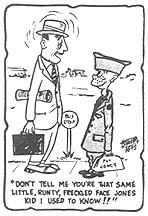 Weapon Safety Healthy Habit
Weapon Safety Healthy Habit
Great care should be taken in the handling of all weapons.
As professional soldiers, you, above all other people should know
how to use caution and forethought when handling any kind of weapon.
There is, however, a dangerous enemy to guard against with the use
of the increased effectiveness of modern hand grenades, rifles and other
weapons. It is familiarity!
Yes, you must get to know your weapons but you must never forget
their potential. Constant use can breed a careless attitude and lack of
fear on the part of the user.
Remember, a little fear, call it respect, for your weapon’s
capabilities. Don’t play games with them. They can kill you as
well as the enemy.
Chieu Hois Not POW’s
Every soldier must know about the Chieu Hoi Program and how to
receive and handle returnees. Once a returnee has been turned over to
Chieu Hoi personnel, he will be treated properly; but during the initial contact
errors can be made.
A Chieu Hoi has been told through leaflets and loudspeakers that he
will receive good care. He has waited for just such an opportunity to turn
himself in.
The Free World soldier must remember that the VC is instructed to
come in during daylight and unarmed. The following points should be kept
in mind:
Anyone who voluntarily turns himself in under any circumstances
will be given Chieu Hoi treatment.
A returnee will be segregated from prisoners of war. He will
be treated with respect and made to feel he has made the right decision.
He will be searched and placed under guard and may be interrogated
to gain tactical intelligence.
If the returnee has hidden weapons an effort should be made to
locate them.
Food, clothing and medical care will be provided as needed, and his
name, rank, location and time he came in will be recorded.
As soon as possible a returnee will be evacuated to a regional or
provincial Chieu Hoi center.
If the returnee has brought in weapons and these are not evacuated
with him, he will be given a receipt to claim a reward.
The TROPIC LIGHTNING NEWS is an authorized publication of the 25th
Infantry Division. It is published weekly for all division units in the Republic of
Vietnam by the Information Office, 25th Infantry Division, APO San Francisco
96225. Army News Features, Army Photo Features, Armed Forces Press Service and Armed
Forces News Bureau material are used. Views and opinions expressed are not necessarily
those of the Department of the Army. Printed in Tokyo, Japan, by Pacific Stars and
Stripes.
MG F. K. Mearns . . . . . . . . . Commanding General
MAJ Andrew J. Sullivan . . Information Officer
2LT Don A. Eriksson . . . . . Officer-in-Charge
SP4 Stephen Lochen . . . . . Editor
SP4 Bill Berger . . . . . . . . . . . Editorial Assistant
Page 3 TROPIC LIGHTNING NEWS July 22, 1968
VC Training Sessions Minus One Officer
3D BDE - Alert 3d Bde, 25th Inf Div troopers canceled a few Viet
Cong training sessions when they killed a traveling enemy training officer in
action north of Dau Tieng.
Two platoons of Bravo Co, 2d Bn, 12th Inf, flushed the
pistol-wielding enemy from a winding maze of brick and bamboo hooches during a
daytime reconnaissance in force.
“He was trying to sneak across to the safety of the rubber
trees,” stated Company Commander 1st Lieutenant Earnest E. Tuggle.
From concealed security positions along a road, the 3d platoon, led
by 1st Lieutenant Alton Funderburk of Horatio, Ark., could see that the VC was
carrying a .45 caliber pistol in his hand. When he stepped into a small
opening in the brush, the Americans opened fire.
A search of the body revealed numerous documents, among which were
several travel authorizations for movement between Viet Cong units in the field
and an outline for use of the 75mm recoilless rifle.
4/9 Plays Robin Hood
1ST BDE - A 25th Inf Div, 1st Bde medic donated 5,500 piasters that
he confiscated from a Viet Cong to the Tay Ninh Orphanage.
Private First Class David Foster of Orange, Tex., was on a
reconnaissance in force patrol with Co A, 4th Bn, 9th Inf when the “Manchu”
infantrymen made contact with an enemy force.
“I confiscated his weapon and was searching him for documents
when I found the money. I guess he must have just gotten paid,” related
Foster.
“Before I was assigned to Alpha Co I was with the S-5 Civic
Action Team. We used to help the orphanage in Tay Ninh. I didn’t
want the money so I thought why not help them out,” commented Foster.
When the battalion returned to Tay Ninh Base Camp, Foster went with
the S-5 section and presented the 5,500 piasters to the orphanage.
25th Division Ensures Graduation
Of Cu Chi High School Students
CU CHI - A large part of the credit for a successful graduation of
high school students at Cu Chi must go to the 25th Inf Div.
The very existence of the Cu Chi High School can be traced to the
protective ring placed around the area by ARVN and 25th Div soldiers. The
classrooms are bullet scarred, and the walls are pocked with shrapnel. But
the school still functions and recently graduated a large class.
Using money from the Aid in Kind Fund, Captain Michael Broadbear of
Atlanta Ga., civic action officer for the Division Support Command, purchased
enough cloth to make 70 dresses and 30 shirts for graduation gifts.
“These clothes along with other gifts went to the children of Cu
Chi who lost their homes during the Tet offensive,” explained Broadbear.
Music was provided for the ceremony by the 25th Div Band and
several shows were produced by ARVN soldiers including a song by a Vietnamese
WAC.
Guests of honor at the graduation were Colonel Ochs, deputy advisor
of III Corps, and Colonel Nhon, province chief of Hau Hghia Province.
During Colonel Nhon’s speech, he directed part of his address, in
English, to the American soldiers thanking, “the U.S. 25th Division on behalf
of the Vietnamese soldiers, civilians, and future generations . . . for their
help and assistance in making this graduation possible.”
Long Haul No Sweat For M-88
CU CHI - What the 725th Maint Bn recovery team thought would be an
ordinary mission turned out to be almost more than they could handle. But,
the M-88 tank retriever proved its worth as it pulled not one but two vehicles
totaling twice its weight back to Cu Chi.
Warrant Officer Albert E. Fox of Vincennes, Ind., track commander
from Headquarters and Company A, received word from Trang Bang that a 155
howitzer was stuck in the mud and its engine was dead. But when he arrived at
Trang Bang a half hour later, he found not only a howitzer, but also another
tank retriever disabled.
When the first tank retriever had gone in to get the howitzer its
front axle bearing had burned up, and the track fell off. Sergeant Bobby
Cole of Troy, Tenn., and Specialist 4 Lorney Deist of Kalispell, Mont., went
into the deep mud to connect the cable.
After the vehicles were pulled to hard ground, the damaged track
from the retriever was pulled in and loaded on a truck. Fox, Cole and
Deist made the final connections to the damaged M-88 and howitzer and Specialist
4 Allen D. Garnor of Muskego, Wis., driver of the tank retriever, started the
M-88 for the long pull home. Pulling twice its weight, the tank retriever
made it back to Cu Chi in less than an hour.
| NARROW DIKE - Private First Class Louis J. Maccouax of Sturgeon Bay, Wis., carrying a 90mm recoilless rifle, recovers in stride after falling off a dike during a 2d Bn, 14th Inf sweep near Saigon. (PHOTO BY PFC ROBERT BOYLE) | 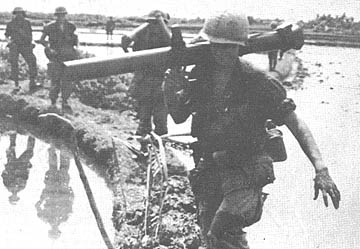 |
Woman Keeps Up Pace With Fast Infantrymen
1ST BDE - A middle-aged Vietnamese woman with the stamina of an
American infantryman earned honorary membership in the 4th Bn (Mech), 23d Inf.
While sweeping a series of villages 13 kms northwest of Saigon, the
25th Inf Div company discovered a woman in their midst. Ignoring her, they
continued their house-to-house search.
But, the woman remained with the company as they waded through rice
paddies and canals. After she had followed the Tomahawks for more
than a mile, the Company Commander, Captain Henry Montgomery of Memphis, Tenn.,
had his interpreter ask her to go back. However, she responded that she
wanted to be with them.
The infantrymen picked up the pace in the hope that the woman would
not be able to keep up. But she was persistent and stayed with the
company.
Realizing the peril she would be in if the company got into a fire
fight, Montgomery asked his interpreter to tell her: “You are now an
honorable member of the Tomahawks.” Upon hearing this, she politely
bowed to the captain and with a smile on her face left “her” company.
Did You Know
Did you know that normally the flag is flown from sunrise to
sunset; however, among other places, it may also be flown both day and night
over the east and west fronts of the U.S. Capitol in Washington D.C.
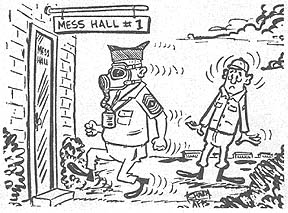 |
Page 4-5 TROPIC LIGHTNING NEWS July 22, 1968
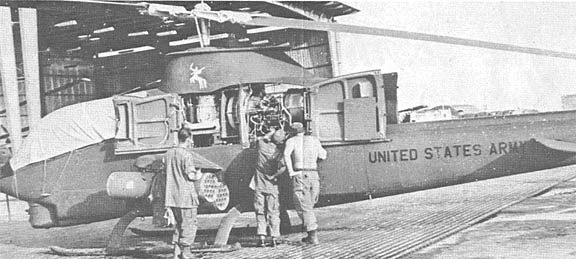 |
| CHECK-UP - A Cobra gunship of D Trp, 3d Sqdn, 4th Cav, is checked by maintenance personnel and the crew chief during a routine inspection. |
They ‘Keep ‘Em Flying’
CU CHI - Many hours of hard work and skilled maintenance are
required to keep each helicopter in the 25th Div in safe, flyable condition.
Repairs and replacements are checked and double checked.
Reams of paper are used in filing work orders, repair slips, historical
documents and the almost infinite number of other things necessary to the
success of every combat mission that is performed by the pilot and crew of a
helicopter.
The most intimate contact between man and machine exists with the
crew chief of each craft. It is his responsibility to make a daily
inspection, usually before the first flight of the day or after the last mission
in the evening.
According to Specialist 4 John Albers, crew chief with D Trp, 3d
Sgdn, 4th Cav, “A crew chief looks mainly for anything loose - rivets working,
bolts slipping, stuff like that. Leaks are another important item,”
explained Albers, of St. Louis. “Often a small leak will mean that a
coupling is loose or a part is worn.”
Most minor repairs are done on the spot by the crew chief.
Any job too large to handle or parts that need replacement are referred to the
unit’s maintenance personnel who have the skill and experience to conduct
second and third echelon maintenance.
Private First Class Gene P. Eisele of Great Neck, N.Y., is a
typical helicopter mechanic. His schooling in the Army “consisted of two
separate courses. I went through one course on general aircraft
maintenance,” explained Eisele, a “stablehand” of D Trp, 3d Sqdn, 4th Cav.
“When I finished that course I was sent to a specialized
school where we spent most of our time actually working on helicopters.”
The aircraft mechanics, often working hand-in-hand with the crew
chiefs, conduct numerous inspections and replace worn or damaged units. A
task that requires massive work or rebuilding is referred to E Co of the 725th
Maint Bn or the 20th Trans Co.
In huge hangars capable of holding more than 20 helicopters at a
time, skilled technicians and avionics mechanics perform major repairs on
helicopters.
“A lot of the work involves replacing engines and rotor
blades,” related Specialist 4 Maurice A. Dieterly, a member of the 725th Maint
Bn from South Lyon, Mich.
“We have sheet metal, electrical, armament and other shops
capable of doing virtually any repair or replacement work necessary,”
emphasized Dieterly.
Numerous safeguards and inspections have been implemented to make
sure that the helicopters are always in top shape.
After every 25 hours of flight the ships are given a thorough
inspection by maintenance personnel and after 100 hours a Periodic Inspection is
conducted.
“On these inspections,” explained Staff Sergeant John
Eichenmiller, a Technical Inspector (TI) assigned to B Co, 25th Avn Bn, “I
spend from two to three hours just going over each craft that comes in.
One of my biggest responsibilities is to insure that all repairs are made
correctly,” he said.
Eichenmiller, a resident of St. Petersburg, Fla., needed five years
of experience with helicopters before he qualified for a job as a TI.
The capabilities of the ground crews servicing the helicopters of
the 25th Div can best be summed up in the words of one pilot: “I’d stake my
life on the mechanics - I have to - and they’ve never let me down.”
|
Story and Photos By SP4 Richard Patterson |
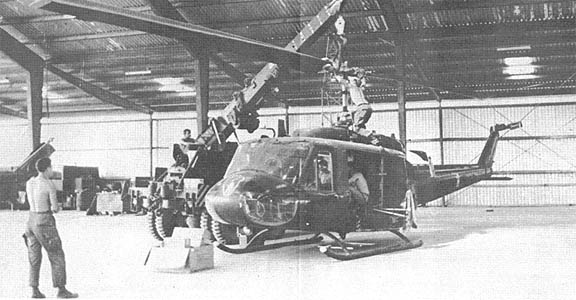 |
| NEW ROTOR - A blade is placed on a UH-1D helicopter by maintenance personnel of the 725th Maint Bn. Inside the giant hangars, largest structures on the Cu Chi base camp, helicopters can be repaired under any weather conditions. |
Page 6 TROPIC LIGHTNING NEWS July 22, 1968
|
|
||||
|
CPT Malcolm D. Otis
“For extraordinary heroism in connection with military operations
involving conflict with an armed hostile force in the Republic of Vietnam:
Captain Otis distinguished himself by exceptionally valorous actions on 31
January 1968 at Tan Son Nhut Air Base in Saigon.
“Viet Cong and North Vietnamese Army forces launched a major
attack against the Saigon area with the mission of seizing control of critical
allied military installations. One of the largest attacks was directed
against the west end of Tan Son Nhut Air Base.
“Arriving at the gate of Tan Son Nhut, he immediately deployed
his troop to the west into the face of the insurgent forces. Without
losing the impetus of his maneuver, Captain Otis then wheeled to the south and
attacked directly into the enemy flank.
“Throughout the seven and one-half hour battle for the hotly
contested terrain, Captain Otis countered each enemy movement with a flanking
force and heavy fire from his guns. Continuously exposing himself to the
intense enemy fusillade, he moved from position to position on the battlefield,
directing the attack and encouraging his men’s fight.
“When the enemy had been decisively beaten, he directed his
forces in a detailed sweep through the area. Captain Otis’s
extraordinary heroism and devotion to duty were in keeping with the highest
traditions of the military service and reflect great credit upon himself, his
unit, and the United States Army.”
2LT Gordon F. Kelley
“For extraordinary heroism in connection with military operations
involving conflict with an armed hostile force in the Republic of Vietnam:
Second Lieutenant Kelley distinguished himself by exceptionally valorous actions
of 2 January 1968 as a platoon leader of an infantry unit defending against a
massive enemy attack on Fire Base Burt.
“The insurgents struck the camp with a murderous night mortar
barrage. Lieutenant Kelley personally insured that his men were under
cover and that they were fully prepared for the ground attack which followed.
“The vanguard of the assault went directly into Lieutenant
Kelley’s platoon position. Throughout the ensuing eight hour battle, he
moved from position to position to adjust his platoon’s fire, relocate
weapons, inspire his men and supervise the treatment and evacuation of wounded
personnel.
“Although painfully wounded by shrapnel, Lieutenant Kelley
refused medical attention and repeatedly braved the relentless enemy fire to
adjust air strikes and artillery to within fifty meters of his own position.
These strikes and the well-directed fires from his superbly led infantrymen
repulsed the fanatic assault.
“Second Lieutenant Kelley’s extraordinary heroism and devotion
to duty were in keeping with the highest traditions of the military service and
reflect great credit upon himself, his unit and United States Army.”
SFC Vicente T. Dydasco
“For extraordinary heroism in connection with military operations
involving conflict with an armed hostile force in the Republic of Vietnam:
Sergeant First Class Dydasco distinguished himself by exceptionally valorous
actions on 28 October, 1967 as platoon sergeant with an infantry battalion on a
search and destroy mission in the Boi Loi Woods.
“While clearing a night defensive position, a sister company
became heavily engaged by an unknown sized enemy force. As Sergeant
Dydasco’s platoon moved to aid the beleaguered force, an enemy complex
consisting of sixty well-fortified bunkers connected by fighting trenches was
encountered.
“Immediately deploying his unit to provide covering fire he and
three others advanced to locate the insurgents. He observed three Viet
Cong moving to another bunker and wounded one before his weapon jammed.
“Armed only with grenades, he crawled after the enemy. Upon
reaching the bunker they occupied, he hurled grenades into it, destroying the
fortification and killing the insurgents.
“Completely disregarding his personal safety, he maneuvered among
the hostile fortifications and destroyed seven bunkers with well-placed
grenades.
“His force encountered intense automatic weapons fire, and he
fearlessly advanced alone to find the location of the emplacement. With
bullets striking all around him, he crawled through the complex. A sniper
in a tree opened up on him, and he killed the insurgent with a deadly burst from
his rifle.
“He continued his tenacious advance, located the enemy gunner and
destroyed his position with a grenade. He then led his platoon in a
orderly withdrawal to allow artillery strikes to soften the enemy positions.
“Sergeant First Class Dydasco’s extraordinary heroism and
devotion to duty were in keeping with the highest traditions of the military
service and reflect great credit upon himself, his unit, and the United States
Army.”
SSG Daniel L. Ireland
“For extraordinary heroism in connection with military operations
involving conflict with an armed hostile force in the Republic of Vietnam:
Staff Sergeant Ireland distinguished himself by exceptionally valorous actions
on 17 January 1968 as an infantry platoon sergeant during a search and destroy
mission of Operation Yellowstone.
“Sergeant Ireland was moving with his company’s point element
when Viet Cong forces launched a savage attack on the unit. He was
momentarily knocked unconscious by an exploding enemy claymore mine but quickly
recovered and delivered a devastating barrage on the attackers.
“After killing two insurgents with grenade launcher fire, he
moved across the bullet-swept battlefield to reorganize his men and direct their
fight against the enemy. Automatic weapons and rocket grenade fire struck
all around him, but he refused to take cover and called for a machine gun to be
brought forward.
“The gunner was wounded as the enemy concentrated its full
firepower on the vital weapon. Sergeant Ireland immediately took charge of
the weapon and covered the withdrawal of the point element to the company
perimeter. After moving back himself, he noticed that the wounded gunner
had not reached safety.
“Completely disregarding his safety, Sergeant Ireland dashed
through a curtain of fire to his fallen comrade and carried him back to friendly
lines. He then returned to the raging battle and deployed his troops to
more effectively repulse the continuing enemy assaults.
“Repeatedly inspiring his men with his heroic actions in the heat
of battle, he directed a tenacious defense which inflicted heavy casualties on
the Viet Cong and forced them to flee.
“Staff Sergeant Ireland’s gallantry in action was in keeping
with the highest traditions of the military service and reflects great credit
upon himself, his unit and the United States Army.”
Page 7 TROPIC LIGHTNING NEWS July 22, 1968
Colonel’s Boots Are Made For Flying
By CPT LES RASCHKO
1ST BDE - A day with an infantry brigade commander, is a picture of
a colonel faced with a multitude of decisions, and one of a man constantly on
the move.
Colonel Fremont B. Hodson, of the 25th Inf Div’s 1st Bde, serves
as an example of a busy infantry leader always in motion. The 43-year-old
colonel from Greenville, S.C.. has averaged 180 hours in the air each month
since taking command of the Lancer Bde as a Lieutenant Colonel on December 19th
of last year.
Under Colonel Hodson the 1st Bde has thus far killed 1,392 enemy
soldiers, captured 352 enemy weapons and detained 37 enemy suspects in
operations Yellowstone, Wilderness, Quyet Thang and Toan Thang I and II.
These operations saw the 1st Bde make contact near Cambodian border, drive deep
into War Zone C, fight throughout Tay Ninh Province and meet the enemy as far
south as Saigon.
Normally a brigade commander is responsible for three maneuver
battalions and support troops. Since the Tet offensive additional
battalions were placed under the operational control of Colonel Hodson. At
one time he had the operational control of seven maneuver battalions and was
responsible for 90 percent of the division’s tactical area of operations.
Hodson was able to direct his troops over this huge battleground
because of the airmobility supplied by, perhaps the commander’s greatest aid,
his Huey helicopter, known as a command and control (C&C) ship.
The Huey chopper supplies the colonel with a bird’s-eye view of
actions on the ground as it continually circles above the fighting troops
radioing enemy positions and command guidance.
The C&C ship has often become a tactical fighting ship.
Both the colonel and his artillery liaison officer, Captain Ronald M. Howard, a
28-year-old native of Alexandria, Va., have killed Viet Cong as their ship
swooped down on enemy they spotted from the air.
Colonel Hodson takes a personal interest in his troops morale.
With a friendly smile and a genuine concern for their problems the colonel
always stops to talk with the soldiers in the field, asking them where they are
from and where they took their training.
Meetings and briefings also make up a large part of the
commander’s day. He attends his brigade’s briefings at Tay Ninh and
divisional briefings at the 25th Infantry Division’s headquarters at Cu Chi.
Briefing VIP’s such as Generals Westmoreland and Abrams as well as visiting
senators and congressmen, is also a function of the brigade commander.
The war of constant change and no front has added another page to
military history – that of the flying infantry commander.
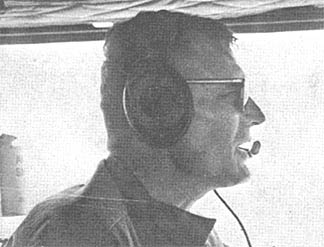 |
COLONEL HODSON IN C&C - The 25th Inf Div’s 1st Bde
commander, Colonel Fremont Hodson, maintains radio contact with his infantry
units on the ground as his command and control helicopter hovers over the action northeast of Cu Chi. (PHOTO BY SP4 RICK ADAMS) |
| COORDINATING - Colonel Hodson coordinates with Lieutenant Colonel Alexandria Hunt, 3d Bde Executive Officer, at Dau Tieng as he leaves the 3d Bde’s operations center reading the day’s plans summary. (PHOTO BY CPT LES RASCHKO) | 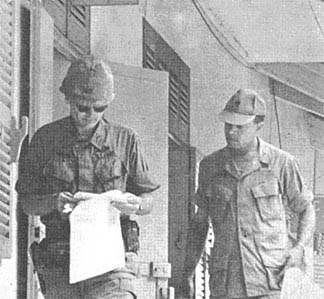 |
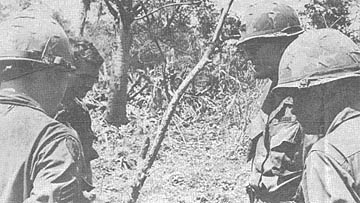 |
HODSON TALKS WITH TROOPS - Colonel Fremont Hodson talks with his soldiers in the field during a lull in the Bde’s fighting near Cu Chi. (PHOTO BY SP4 RICK ADAMS) |
| AT A FIRE SUPPORT BASE - With Nui Ba Den mountain in the background, Colonel Hodson discusses artillery at Fire Support Base Saint Barbara, as he waits to fly two enemy suspects detained by 1st Bde soldiers earlier that day to Tay Ninh. (PHOTO BY CPT LES RASCHKO) |  |
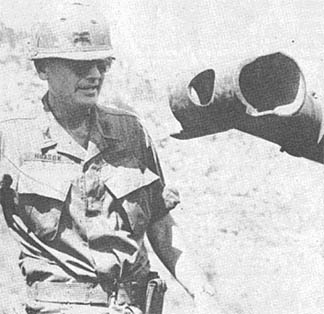 |
IN THE FIELD - In the field with the 2d Bn, 34th Armor, Colonel Hodson gets a close look at what makes Charlie run. (PHOTO BY CPT LES RASCHKO) |
Page 8 TROPIC LIGHTNING NEWS July 22, 1968
|
Write for Your Ballot And Vote |
BG Long Arrives
(Continued From Page 1)
Following World War II, Gen. Long served in Austria where he was
the Assistant Chief of Staff, G3, HQ Zone Command, Austria. He attended
the US Army Command and General Staff College in 1950-51. Upon graduation,
he was assigned to the Office of the Assistant Chief of Staff, G2, Department of
Army as a research analyst and as a Policy and Plans Officer.
In September 1954, he joined the 24th Inf Div in Korea first
serving as the Executive Officer, 21st Inf (Gimlet) Regt; second. Assistant
Chief of Staff, G3, and third, Commander of the 21st Inf (Gimlet) Regt.
He attended the Armed Forces Staff College in Norfolk in 1956 and
from 1956-59 served on the faculty of the Command and General Staff College at
Fort Leavenworth. At the college, he was successively the Chief of the
Defense Section, Offense Section, Department of the Infantry Division and the
Chief Staff Section, Department of the Staff and Education Department.
After attending and graduating from the National War College in
1960, he was assigned to Supreme Headquarters, Allied Powers in Europe (SHAPE),
as a staff officer in the Organization and Training Division.
In 1962-63 he served as Chief of Staff of the 3d Inf Div in
Germany. In 1963 he was ordered to Washington for duty with the Defense
Intelligence Agency. Subsequently, he served in the Office of the Chief of
Staff of the Army where he was the Chief of the Coordination Division and Deputy
Director, Office Director Coordination and Analysis.
In April, 1966, Gen. Long became Chief of Staff for the VII Corps
in Stuttgart, Germany.
The General’s last assignment before arriving in Vietnam was
Assistant Division Commander, 3d Armored Div spearhead, Hanau, Germany.
Bunkers Taken
3D BDE - A combined air and ground attack north of Saigon netted
eight Viet Cong bodies for a unit of the 3d Bde, 25th Inf Div.
As Alpha Co, 3d Bn, 22d Inf was conducting a day sweep operation in
rice paddies north of the capital, 16 enemy soldiers were spotted by supporting
gunships.
As the Hueys raked the area with heavy fire, the “Regulars”
company advanced upon what proved to be a well-fortified bunker complex.
“The VC tried to slow us down by sniper fire,” said Company
Commander 1LT Alfred D. Fletcher of Washington, D.C., “but our attack proved
to be more than they could handle.”
As the enemy fled, the American troops moved in and conducted a
thorough search of the bunker system. They turned up, in addition to the
eight bodies, eight AK-47 assault rifles and a pistol.
| DA AWARD FOR SAFETY - Lieutenant General Frank T. Mildren, USARV deputy commanding general, presents the Department of the Army Award of Honor for Safety to Brigadier General William T. Gleason, acting commander of the 25th Inf Div. In part, the award read: “The Division distinguished itself by effecting a significant reduction in accidents in comparison with its record for the previous year.” The Award of Honor is the highest award in the Army’s Safety Program. (PHOTO BY SP4 ROBERT SMITH) | 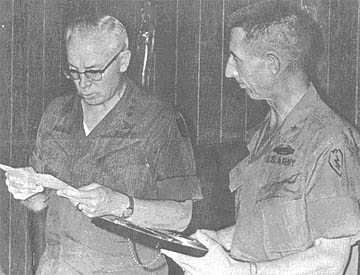 |
Tomahawk Hails From School Of Hard Knocks
1ST BDE - A professional Cowboy turned Tomahawk has found that the
gridiron is not the only place to learn about teamwork.
Sergeant Tony Jenkins, formerly a football kicking specialist with
the Dallas Cowboys, is now the acting platoon sergeant with the 25th Inf Div’s
Recon Plt, 4th Bn (Mech), 23d Inf.
Asked about the change of teams he said: “The infantry is very
similar to a game on a Sunday afternoon. You win or lose because of
teamwork. I learned this well while with the Cowboys, but the men in my
platoon have taught me quite a bit more about teamwork. I’m just proud
to be a member of the Tomahawks.”
Jenkins, of Stamford, Tex., played varsity football for the
University of Oklahoma, and as a kicking specialist caught the eye of many
professional football scouts. After several successful seasons in college,
he signed with the Cowboys.
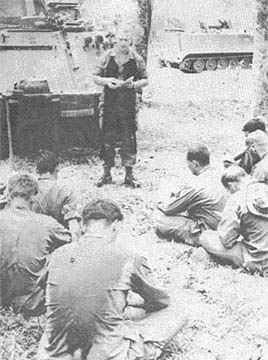 |
CHAPLAIN - Major Richard K. Martin, Brigade Chaplain for the 3d Bde, 25th Inf Div, conducts Protestant services for men of the 2d Bn, 22d Inf along the Dau Tieng to Tay Ninh road. (PHOTO BY I LT J.M. O’BRIEN) |
Thanks to
Allan Azary, 1st Bn. (Mechanized), 5th Inf. for sharing this issue,
Kirk Ramsey, 2nd Bn., 14th Inf. for creating this page.
This page last modified 8-12-2004
©2004 25th Infantry Division Association. All rights reserved.